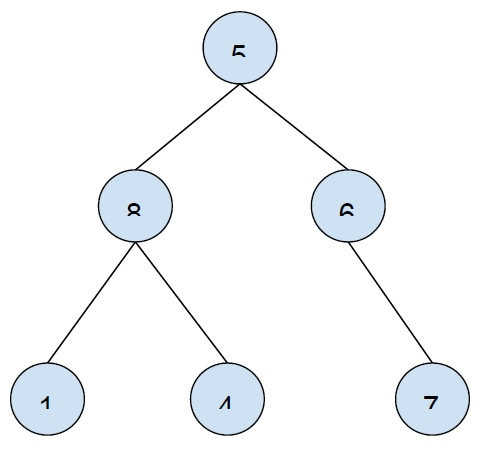
 Data Structure
Data Structure Networking
Networking RDBMS
RDBMS Operating System
Operating System Java
Java MS Excel
MS Excel iOS
iOS HTML
HTML CSS
CSS Android
Android Python
Python C Programming
C Programming C++
C++ C#
C# MongoDB
MongoDB MySQL
MySQL Javascript
Javascript PHP
PHP
- Selected Reading
- UPSC IAS Exams Notes
- Developer's Best Practices
- Questions and Answers
- Effective Resume Writing
- HR Interview Questions
- Computer Glossary
- Who is Who
Print all leaf nodes of an n-ary tree using DFS in C++
In this problem, we are given a 2-D array containing the edge of an n-ary where edge defines the edge of the n-ary tree. We have to print all the leaf nodes of the created a-ary tree.
The n-ary tree is a tree with has maximum n children i.e. a node can have 1, 2, ...n child nodes.
Let’s see an example to understand the problem −
Input: edge[][] = {{5,8}, {5,6}, {8,1}, {8,4}, {6,7}}
Output: 1 4 7
Explanation − let's create a tree using the edge array −

The leaf nodes of this tree are 1, 4, 7.
To solve this problem, we will traverse the tree using DFS (it will find the leaf node of every subtree). Also, visited nodes of the array are marked. If the node has a child (if not leaf node), we will flag the value and print nodes without a child node.
Example
This program shows the implementation of our solution −
#include <bits/stdc++.h>
using namespace std;
void DFS(list<int> t[], int node, int parent) {
int flag = 0;
for (auto ir : t[node]) {
if (ir != parent) {
flag = 1;
DFS(t, ir, node);
}
}
if (flag == 0)
cout<<node<<"\t";
}
int main() {
list<int> t[1005];
pair<int, int> edges[] = {
{ 1, 2 },
{ 1, 3 },
{ 2, 4 },
{ 3, 5 },
{ 3, 6 },
{ 3, 7 },
{ 6, 8 }
};
int cnt = sizeof(edges) / sizeof(edges[0]);
int node = cnt + 1;
for (int i = 0; i < cnt; i++) {
t[edges[i].first].push_back(edges[i].second);
t[edges[i].second].push_back(edges[i].first);
}
cout<<"Leaf nodes of the tree are:\n";
DFS(t, 1, 0);
return 0;
}
Output
Leaf nodes of the tree are − 4 5 8 7

Advertisements
